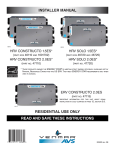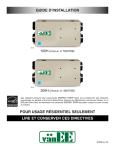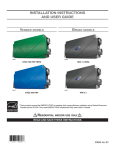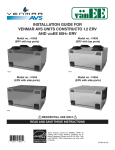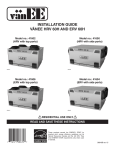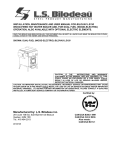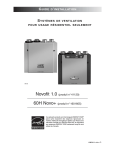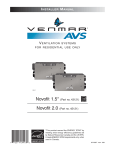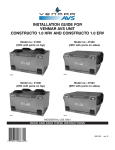Download "user manual"
Transcript
INSTALLER MANUAL VB0168 HRV NOVOFIT 1.5ES (PART NO. 46121) VB0169 HRV NOVOFIT 2.0ES (PART NO. 47121) THESE PRODUCTS EARNED THE ENERGY STAR® BY MEETING STRICT ENERGY EFFICIENCY GUIDELINES SET BY NATURAL RESOURCES CANADA AND THE US EPA. THEY MEET ENERGY STAR REQUIREMENTS ONLY WHEN USED IN CANADA. RESIDENTIAL USE ONLY READ AND SAVE THESE INSTRUCTIONS 20512 REV. 06 ABOUT THIS MANUAL Please take note that this manual uses the following symbols to emphasize particular information: ! WARNING Identifies an instruction which, if not followed, might cause serious personal injuries including possibility of death. CAUTION Denotes an instruction which, if not followed, may severely damage the unit and/or its components. NOTE: Indicates supplementary information needed to fully complete an instruction. We welcome any suggestions you may have concerning this manual and/or the unit, and we would appreciate hearing your comments on ways to better serve you. Please contact us by phone at 1-800-567-3855. NOTE: This installation manual refers to Novoclimat™ requirements. The specifications are subject to change without notice. For more details, refer to Novoclimat program. Novoclimat is a performing dwelling concept created by the Agence de l’efficacité énergétique du Québec, to insure comfort, health and savings for the occupants. Many requirements, mainly for the building envelope, tightness and ventilation must be met for a house to be Novoclimat certified. Venmar has conceived a unit with all the HRV features required by this concept. Please note that Novoclimat also has specific requirements regarding the system and ducts installation and balancing. ABOUT THESE UNITS LIMITATION For residential (domestic) installation only. Installation work and electrical wiring must be done by a qualified person(s) in accordance with all applicable codes and standards, including fire-rated construction codes and standards. ! WARNING TO REDUCE THE RISK OF FIRE, ELECTRIC SHOCK, OR INJURY TO PERSON(S) OBSERVE THE FOLLOWING: 1. Use this unit only in the manner intended by the manufacturer. If you have questions, contact the manufacturer at the address or telephone number listed in the warranty. 2. Before servicing or cleaning this unit, disconnect power cord from electrical outlet. 3. This unit is not designed to provide combustion and/or dilution air for fuel-burning appliances. 4. When cutting or drilling into wall or ceiling, do not damage electrical wiring and other hidden utilities. 5. Do not use this unit with any solid-state speed control device other than following main wall controls: Altitude or Deco-Touch, and no other optional auxiliary controls than 60-minute crank timer and/or 20/40/60-minute push-button timer. 6. This unit must be grounded. The power supply cord has a 3-prong grounding plug for your personal safety. It must be plugged into a mating 3-prong grounding receptacle, grounded in accordance with the national electrical code and local codes and ordinances. Do not remove the ground prong. Do not use an extension cord. 7. Do not install in a cooking area or connect directly to any appliances. 8. Do not use to exhaust hazardous or explosive materials and vapors. 9. When performing installation, servicing or cleaning this unit, it is recommended to wear safety glasses and gloves. 10. Due to the weight of the unit, two installers are recommended to perform installation. 11. When applicable local regulation comprise more restrictive installation and/or certification requirements, the aforementioned requirements prevail on those of this document and the installer agrees to conform to these at his own expenses. CAUTION 1. 2. 3. 4. 5. To avoid prematurate clogged filters, turn OFF the unit during construction or renovation. Please read specification label on product for further information and requirements. Be sure to duct air outside – Do not intake/exhaust air into spaces within walls or ceiling or into attics, crawl spaces, or garage. Intended for residential installation only in accordance with the requirements of Part 9 of the National Building Code of Canada. Do not run any air ducts directly above or closer than 2 ft (0.61 m) to any furnace or its supply plenum, boiler, or other heat producing appliance. If a duct has to be connected to the furnace return plenum, it must be connected not closer than 9’ 10” (3 m) from this plenum connection to the furnace. 6. The ductwork is intended to be installed in compliance with all local and national codes that are applicable. 7. When leaving the house for a long period of time (more than two weeks), a responsible person should regularly check if the unit operates adequately. 2 TABLE OF CONTENTS 1. SIZING ........................................................................................................................................................ 4 2. TECHNICAL DATA .................................................................................................................................... 4-5 2.1 2.2 2.3 2.4 2.5 AIR DISTRIBUTION (NORMAL OPERATION) ........................................................................................................................ 4 AIR DISTRIBUTION (DEFROST MODE) ............................................................................................................................. 4 DEFROST CYCLES TABLES ............................................................................................................................................. 4 DIMENSIONS ............................................................................................................................................................... 4 SPECIFICATIONS ........................................................................................................................................................... 5 3. TYPICAL INSTALLATIONS .......................................................................................................................... 5 3.1 FULLY DUCTED SYSTEM ............................................................................................................................................... 5 3.2 SYSTEM COMBINED WITH A FURNACE ............................................................................................................................. 5 4. INSTALLATION ....................................................................................................................................... 6-10 4.1 4.2 4.3 4.4 INSPECT THE CONTENT OF THE BOX................................................................................................................................ 6 LOCATING AND MOUNTING THE UNIT ............................................................................................................................... 6 PLANNING OF THE DUCTWORK........................................................................................................................................ 6 CALCULATING THE DUCT SIZE ........................................................................................................................................ 7 4.4.1 EXAMPLE OF CALCULATION ..................................................................................................................................................... 7 4.4.2 REGISTERS LOCATION AND AIR FLOWS DISTRIBUTION .................................................................................................................. 7 4.5 INSTALLING THE DUCTWORK AND THE REGISTERS .............................................................................................................. 8 4.5.1 FULLY DUCTED SYSTEM ......................................................................................................................................................... 8 4.5.2 SYSTEM COMBINED WITH A FURNACE ........................................................................................................................................ 8 4.6 CONNECTING THE DUCTS TO THE UNIT ........................................................................................................................... 9 4.7 INSTALLING THE EXTERIOR HOODS ............................................................................................................................... 10 4.8 CONNECTING THE DRAIN ............................................................................................................................................ 10 5. CONTROLS ........................................................................................................................................... 11-12 5.1 INTEGRATED CONTROL ............................................................................................................................................... 11 5.1.1 BOOT SEQUENCE .................................................................................................................................................................11 5.1.2 SETTING EXTENDED DEFROST ................................................................................................................................................11 5.2 ELECTRICAL CONNECTION TO OPTIONAL WALL CONTROLS ...........................................................................................11-12 5.2.1 ELECTRICAL CONNECTION TO ALTITUDE MAIN WALL CONTROL ......................................................................................................12 5.2.2 ELECTRICAL CONNECTION TO DECO-TOUCH MAIN WALL CONTROL ................................................................................................12 5.2.3 ELECTRICAL CONNECTION TO OPTIONAL AUXILIARY WALL CONTROLS ............................................................................................12 6. ELECTRICAL CONNECTION TO THE FURNACE ....................................................................................13 7. WIRING DIAGRAM .....................................................................................................................................14 8. BALANCING THE UNIT ..............................................................................................................................15 8.1 WHAT YOU NEED TO BALANCE THE UNIT ....................................................................................................................... 15 8.2 PRELIMINARY STAGES TO BALANCE THE UNIT ................................................................................................................ 15 8.3 BALANCING PROCEDURE ............................................................................................................................................ 15 9. OVERALL VERIFICATION ..........................................................................................................................16 9.1 OPTIONAL MAIN CONTROLS ........................................................................................................................................ 16 9.1 OPTIONAL AUXILIARY CONTROLS ................................................................................................................................. 16 10. MAINTENANCE / INSTRUCTIONS FOR USER ........................................................................................17 11. SERVICE PARTS ........................................................................................................................................18 12. TROUBLESHOOTING .......................................................................................................................... 19-20 3 1. SIZING On high speed, the Novofit 1.5ES units produce about 150 cfm, and Novofit 2.0ES units produce about 192 cfm. According to the Novoclimat Ventilation needs vs. the number of rooms chart, the Novofit 1.5ES units can be installed in house having up to 13 rooms*, and Novofit 2.0ES can be installed in house having up to 16 rooms*. *Houses with a non finished section having an area less than 2/3 of the house, or without basement. Refer to Novoclimat requirements for more details. 2. TECHNICAL DATA 2.1 AIR DISTRIBUTION (NORMAL OPERATION) 2.2 AIR DISTRIBUTION (DEFROST MODE) VF0053 VF0052 2.3 DEFROST CYCLES TABLES HRV NOVOFIT 1.5ES OUTSIDE TEMPERATURE DEFROST CYCLES (MINUTES) CELCIUS (°C) FAHRENHEIT (°F) DEFROSTING OPERATION TIME BETWEEN EACH DEFROST CYCLES EXTENDED DEFROST CYCLES (MINUTES) DEFROSTING OPERATION TIME BETWEEN EACH DEFROST CYCLES -5 23 7 50 10 30 -15 5 7 25 10 20 -27 -17 10 20 10 15 HRV NOVOFIT 2.0ES OUTSIDE TEMPERATURE DEFROST CYCLES (MINUTES) CELCIUS (°C) FAHRENHEIT (°F) DEFROSTING OPERATION TIME BETWEEN EACH DEFROST CYCLES EXTENDED DEFROST CYCLES (MINUTES) DEFROSTING OPERATION TIME BETWEEN EACH DEFROST CYCLES -5 23 6 50 10 30 -15 5 6 25 10 20 -27 -17 10 20 10 15 NOTE: The Novofit Performance Charts are listed on the specification sheets of these units. Visit our website at www.venmar.ca to access those documents. 2.4 DIMENSIONS 35” (891 mm) Hooks Location for Hanging Chains 17¼” (438 mm) 30¼” (768 mm) Motorized Damper Terminal Block Location 17” (432 mm) Heat Recovery Core Door VK0077A Power Cord 36” (914 mm) Blower Assembly 4 6” (152 mm) 2. TECHNICAL DATA (CONT’D) 2.5 SPECIFICATIONS MODEL HRV NOVOFIT 1.5ES HRV NOVOFIT 2.0ES WEIGHT 65 LB. (29.5 kg) 65 LB. (29.5 kg) PORT DIAMETER 6" (152 MM) 6" (152 MM) DRAIN DIAMETER 1/2" (12 MM) 1/2" (12 MM) INSTALLATION CHAINS AND SPRINGS (PROVIDED WITH THE UNIT) MOTOR SPEED HIGH AND LOW SPEED FACTORY SET (OPTIONAL INCREASED LOW SPEED) ELECTRICAL SUPPLY 120 V, 60 HZ 120 V, 60 HZ POWER CONSUMPTION 160 WATTS 195 WATTS 3. TYPICAL INSTALLATIONS There are two common installation methods. 3.1 FULLY DUCTED SYSTEM (Primarily for homes with radiant hot water or electric baseboard heating. See illustration at right.) Moist, stale air is exhausted from the high humidity areas in the home, such as bathrooms, kitchen and laundry room. Fresh air is supplied to bedrooms and principal living areas. See 4.5.1 for details VH0077 3.2 SYSTEM COMBINED WITH A FURNACE (For homes with forced air heating. See illustration at right.) Moist, stale air is exhausted from the high humidity areas in the home, such as bathrooms, kitchen and laundry room. Fresh air is supplied to the cold air return or the supply duct of the furnace. NOTE: For this type of installation, it is essential that the furnace blower runs when the unit is in operation. See 4.5.2 for details VH0087 5 4. INSTALLATION ! WARNING When applicable local regulations comprise more restrictive installation and/or certification requirements, the aforementioned requirements prevail on those of this document and the installer agrees to conform to these at his own expenses. ! WARNING When performing installation, servicing or cleaning the unit, it is recommended to wear safety glasses and gloves. 4.1 INSPECT THE CONTENT OF THE BOX • Inspect the exterior of the unit for shipping damage. Ensure that there is no damage to the door, door latches, door hinges, dampers, duct collars, cabinet, etc. • Inspect the interior of the unit for damage. Ensure that the fan motor assembly, heat recovery core, insulation, dampers, damper actuator and condensation tray are all intact. • If the unit was damaged during shipping, contact your local distributor. (Claim must be made within 24 hours after delivery.) WING NUT SHIPPING BRACKET NOTE: Prior to install the unit, remove its shipping bracket by unscrewing its wing nut and loosing its both retaining screws. RETAINING SCREWS VD0283 4.2 LOCATING AND MOUNTING THE UNIT Choose an appropriate location for the unit: • Within an area of the house where the ambient temperature is kept between 10°C (50°F) and 40°C (104°F) • Away from living areas (dining room, living room, bedroom), if possible • So as to provide easy access to the interior cabinet for every three months and annual maintenance, and to the control panel on the side of the unit; • Close to an exterior wall, so as to limit the length of the insulated flexible duct to and from the unit • Close to a drain. If no drain is close by, use a pail to collect run-off VD0037 • Away from hot chimneys, electrical panel and other fire hazards • Allow for a power source (standard outlet) Hang the unit with the 4 chains and springs provided (see illustrations at right). VD0279 4.3 PLANNING OF THE DUCTWORK a) Follow the instructions in Section 4.4 (next page) to determine the appropriate duct diameters for your system. b) Keep it simple. Plan for a minimum number of bends and joints. Keep the length of insulated duct to a minimum. c) Do not use wall cavities as ducts. Do not use branch lines smaller than 4” Ø (102 mm Ø). d) Do not ventilate crawl spaces or cold rooms. Do not attempt to recover the exhaust air from a dryer or a range hood. This would cause clogging of the recovery module. Use rigid ducts for fresh air distribution and stale air exhaust (“warm” side of HRV) and sheet metal for the kitchen exhaust duct (if need be). e) Be sure to plan for at least one exhaust register on the highest lived-in level of the house if it has 2 floors or more. 6 4. INSTALLATION (CONT’D) 4.4 CALCULATING THE DUCT SIZE Use the table below to ensure that the ducts you intend to install will be carrying air flows at or under the recommended values. Avoid installing ducts that will have to carry air flows near the maximum values and never install a duct if its air flow exceeds the maximum value. NOVOCLIMAT CHART FOR SIZE OF DUCT CONNECTED TO REGISTER VS. AIR FLOW ROUND DUCT RECTANGULAR DUCT MAXIMUM AIR FLOW 4" 2¼" OR 3¼" X 10" 19 L/S (40 CFM) 5" 2¼" OR 3¼" X 10" 31 L/S (65 CFM) 6" 3¼" OR 4" X 10" 52 L/S (110 CFM) NOTE: Example 4.4.1 uses imperial measures. The same calculation applies to metric measures. 4.4.1 EXAMPLE OF CALCULATION PROBLEM: My installation requires two exhaust registers (both for the bathrooms). I will connect these END registers to a main duct which will connect to the unit (high speed performance value of 110 cfm). BRANCHES What size of duct should I use for the main exhaust duct and for the two end branches leading to the 5"ø, registers? (See illustration at right.) 55 CFM SOLUTION: Main duct: Table above indicates a 6” Ø duct: maximum air flow: 110 cfm. The high speed air flow of 110 cfm equals the maximum value (110). Therefore a 6” Ø duct or larger is an appropriate choice for the main exhaust duct. End branches: Each end branch will have to transport an air flow of 55 cfm (110 divided by 2). Table above indicates a 5” Ø duct: maximum air flow: 65 cfm. The high speed air flow of 55 cfm is far enough away from the maximum value (65). Therefore a 5” Ø duct or larger is an appropriate choice VI0003 for both end branches. MAIN BRANCH 6"ø, 110 CFM NOTE: A 4” Ø duct would have been too small because the maximum acceptable value for a 4” Ø duct is 40 cfm. 4.4.2 REGISTERS LOCATION AND AIR FLOWS DISTRIBUTION The registers location and the air flow distribution must be taken in account when performing ductwork installation. Refer to the Novoclimat table below to plan the registers location. REGISTER LOCATION FRESH AIR FLOWS MINIMUM REQUIRED EXHAUST AIR FLOWS MAXIMUM ACCEPTABLE MINIMUM REQUIRED MAXIMUM ACCEPTABLE KITCHEN – – 0 – DINING ROOM 4.7 L/S (10 CFM) 11.8 L/S (25 CFM) – – LIVING ROOM 4.7 L/S (10 CFM) 18.9 L/S (40 CFM) – – OFFICE 4.7 L/S (10 CFM) 9.4 L/S (20 CFM) – – RECREATION ROOM 4.7 L/S (10 CFM) 18.9 L/S (40 CFM) – – MASTER BEDROOM 9.4 L/S (20 CFM) 9.4 L/S (20 CFM) – – SECONDARY BEDROOM(S) 4.7 L/S (10 CFM) 9.4 L/S (20 CFM) – – MAIN BATHROOM – – 23.6 L/S (50 CFM) – SECONDARY BATHROOM(S) – – 14.2 L/S (30 CFM) – LAUNDRY ROOM – – 0 – WORKSHOP – – 0 – NON-FINISHED BASEMENT 4.7 L/S (10 CFM) 18.9 L/S (40 CFM) – – 7 4. INSTALLATION (CONT’D) 4.5 INSTALLING THE DUCTWORK AND THE REGISTERS ! WARNING Never install a stale air exhaust register in a room where there is a combustion device, such as a gas furnace, a gas water heater or a fireplace. CAUTION The ductwork is intended to be installed in compliance with all local and national codes that are applicable. 4.5.1 FULLY DUCTED SYSTEM (AS ILLUSTRATED IN SECTION 3.1) STALE AIR EXHAUST DUCTWORK: • Install registers in areas where contaminants are produced: Bathrooms, laundry room, etc. • Install registers 6 to 12 inches (152 to 305 mm) from the ceiling on an interior wall OR install them in the ceiling (the duct leading to the register must never go through the attic). • If a register is installed in the kitchen, it must have a washable filter and be located at least 4 feet (1.2 m) from the range. • If possible, measure the velocity of the air flowing through the registers. If the velocity is higher than 400 ft/min. (122 m/min), then the register type is too small. Replace with a larger one. FRESH AIR DISTRIBUTION DUCTWORK: • Install registers in every bedrooms, in living room and a minimum of one per level without bedroom nor living room. • Install registers high on the walls with air flow directed towards the ceiling. The horizontal draft must be perceptible at 3 ft. (910 mm) from register (The cooler air will then cross the upper part of the room and mix with room air before descending to occupant level.) 4.5.2 SYSTEM COMBINED WITH A FURNACE (AS ILLUSTRATED IN SECTION 3.2) STALE AIR EXHAUST DUCTWORK: Same as for Fully Ducted System, described on point 4.5.1 above) FRESH AIR DISTRIBUTION: ! WARNING When performing duct connection to the furnace, installation must be done in accordance with all applicable codes and standards. Please refer to your local building code. • Cut an opening into the furnace return duct not less than 10 feet (3.1 m) from the furnace (A+B). • Connect this opening to one end of the top section of a metal T coupling (the T will be reversed, see shaded part in illustration at right). • Connect the other end of the T coupling top section to the fresh air distribution port of the HRV (see illustration at right) NOTE: For this case, it is essential that the furnace blower runs when the unit is in operation. Synchronize the furnace blower operation with the HRV operation (see Section 6). 8 A B VJ0089 A+B= NOT LESS 10’ (3.1 M) THAN 4. INSTALLATION (CONT’D) 4.6 CONNECTING THE DUCTS TO THE UNIT INSULATED FLEXIBLE DUCTS NOTE: When using flexible ducts, the complete duct run must be accessible and kept as short as possible. Use the following procedure for connecting the insulated flexible duct to the ports on the unit (exhaust to outside and fresh air from outside). Pull back the insulation to expose the flexible duct and place it over inner port ring. Install good quality aluminum duct tape on flexible duct to prevent potential water leakage from duct. Attach the flexible duct to the port using tie wrap. Pull the insulation over the joint and tuck it between the inner and outer rings of the double collar. Pull down the vapor barrier (shaded part in illustrations below) over the outer ring to cover it completely. Fasten in place the vapor barrier using the port strap (included in unit parts bag). To do so, insert one collar pin through vapor barrier and first strap hole, then insert the other collar pin through vapor barrier and center strap hole and close the loop by inserting the first collar pin in the last strap hole. CAUTION Make sure the vapor barrier on the insulated ducts does not tear during installation to avoid condensation within the ducts. 1 2 3 4 5 COLLAR PIN VJ0091 COLLAR PIN RIGID DUCTS NOTE: Rigid ducts connected to the cold side of the unit must have a minimum insulation of R4. To prevent potential water leakage from ducts, use good quality aluminum duct tape to connect the rigid ducts to the ports. CAUTION Do not use screws to connect rigid ducts to the ports. Make sure that both balancing dampers are left in a fully open position before connecting the ducts to Fresh air to building port and Exhaust air from building port (as shown in illustration at right). VJ0088 9 4. INSTALLATION (CONT’D) 4.7 INSTALLING THE EXTERIOR HOODS Choose an appropriate location for installing the exterior hoods: 6” ø (152 MM) EXHAUST HOOD • At a minimum distance of 6 feet (1.8 m) between the hoods to avoid cross-contamination INTAKE HOOD • At a minimum distance of 18 inches (457 mm) from the ground 18” (457 MM) 18” (457 MM) 6’ (1.8 M) ! WARNING Make sure the intake hood is at least 6 feet (1.8 m) away from any of the following: • Dryer exhaust, high efficiency furnace vent, central vacuum vent • Gas meter exhaust, gas barbecue-grill • Any exhaust from a combustion source • Garbage bin and any other source of contamination 6’ (1.8 M) OPTIONAL 18” (457 MM) DUCT LOCATION TAPE AND DUCT TIE CAULKING Refer to illustration at right for connecting the insulated duct to the hoods. An “Anti-Gust Intake Hood” should be installed in regions where a lot of snow is expected to fall. VD0028 4.8 CONNECTING THE DRAIN Cut 2 sections of the plastic tube, minimum 12” long, and attach them to each inner drain fitting, located under the unit. Join both short sections to the “T” junction and main tube as shown, to prevent the unit from drawing unpleasant odors from the drain source. TIE WRAP 12” minimum VD0325A Run the tube to the floor drain or to an alternative drain pipe or pail. IMPORTANT If using a pail to collect water, locate the tube end approximately 1” from the top of the pail in order to prevent water from being drawn back up into the unit. ± 1” VD0308A 10 12” minimum 5. CONTROLS 5.1 INTEGRATED CONTROL All units are equipped with an integrated control, located in front of the electrical compartment. Use the push button (1) to control the unit. The LED (2) will then show on which mode the unit is in. NOTES: 1. The integrated control must be turned OFF to use an optional main control. 2. If an optional auxiliary control is used, if activated, this auxiliary control will override the optional main control. 2 1 VD0278 Refer to table below to see how to operate the unit using its integrated control. PRESS ON PUSH BUTTON LED COLOR RESULTS ONCE AMBER UNIT IS ON LOW SPEED TWICE GREEN UNIT IS ON HIGH SPEED THREE TIMES NO LIGHT UNIT IS OFF If a problem occurs during the unit operation, its integrated control LED (2) will blink. The color of the blinking light depends on the type of error detected. Refer to Section 12 Troubleshooting on pages 19 and 20 for further details. 5.1.1 BOOT SEQUENCE The unit boot sequence is similar to a personnal computer boot sequence. Each time the unit is plugged after being unplugged, or after a power failure, the unit will perform a 30-second booting sequence before starting to operate. During the booting sequence, the integrated control LED will light GREEN (unit set in normal defrost) or AMBER (unit set in extended defrost) for 5 seconds, and then will shut off for 2 seconds. After that, the LED will light RED for the rest of the booting sequence. During this RED light phase, the unit is checking and resetting the motorized damper position. Once the motorized damper position completely set, the RED light turns off and the booting sequence is done. NOTE: No command will be taken until the unit is fully booted. 5.1.2 SETTING EXTENDED DEFROST The unit is factory set to normal defrost. In cold region, it may be necessary to setup extended defrost. During the first 5 seconds of booting sequence, while the integrated control LED is GREEN, press on push button until the LED turns AMBER (about 3 seconds). VD0281 5.2 ELECTRICAL CONNECTION TO OPTIONAL WALL CONTROL For more convenience, this unit can also be controlled using an optional main wall control. ! WARNING Always disconnect the unit before making any connections. Failure in disconnecting power could result in electrical shock or damage of the wall control or electronic module inside the unit. CAUTION Never install more than one optional main wall control per unit. Make sure that the wires do not short-circuit between themselves or by touching any other components on the wall control. Avoid poor wiring connections. To reduce electrical interference (noise) potential, do not run wall control wiring next to control contactors or near light dimming circuits, electrical motors, dwelling/building power or lighting wiring, or power distribution panel. 11 5. CONTROLS (CONT’D) 5.2 ELECTRICAL CONNECTION TO OPTIONAL WALL CONTROL (CONT’D) B A Use the terminal connector included in the installation kit to perform the electrical connection for main and auxiliary wall controls. Check if all wires are correctly inserted in their corresponding holes in the terminal block. (A wire is correctly inserted when its orange receptacle is lower than another one without wire. On illustration at right, wire A is correctly inserted, but not wire B.) VE0272 Once the wall control(s) connections have been made, insert the terminal connector in the electrical compartment front face. NOTE: For information about the operation of the wall controls, refer to the user guide. TERMINAL CONNECTOR LOCATION VD0278 5.2.2 ELECTRICAL CONNECTION TO DECO-TOUCH MAIN WALL CONTROL 5.2.1 ELECTRICALCONNECTION TO ALTITUDE MAIN WALL CONTROL NO C NC I OC OL Y R G B MODE PREF SET NO C NC I OC OL Y R G B SMART VE0250 VE0175 5.2.3 ELECTRICAL CONNECTION TO OPTIONAL AUXILIARY WALL CONTROLS 60-MINUTE CRANK TIMER 20/40/60-MINUTE PUSH-BUTTON TIMER NO C NC I OC OL Y R G B VE0294A 12 6. ELECTRIC CONNECTION TO THE FURNACE ! WARNING Never connect a 120-volt AC circuit to the terminals of the furnace interlock (standard wiring). Only use the low voltage class 2 circuit of the furnace blower control. FOR A FURNACE CONNECTED TO A COOLING SYSTEM: On some older thermostats, energizing the “R” and “G” terminals at the furnace has the effect of energizing “Y” at the thermostat and thereby turning on the cooling system. If you identify this type of thermostat, you must use the ALTERNATE FURNACE INTERLOCK WIRING. STANDARD FURNACE INTERLOCK WIRING THERMOSTAT TERMINALS FOUR WIRES TWO WIRES heating only W R G W 4 WIRES G Y THERMOSTAT TERMINAL 2 WIRES heating only wiring nuts W RR NO NC G C C C YY Y FURNACE 24-VOLT TERMINAL BLOCK R UNIT TERMINAL CONNECTOR Y NO C NC I OC OL Y R G B G UNIT TERMINAL CONNECTOR R NO C NC I OC OL Y R G B W ALTERNATE FURNACE INTERLOCK WIRING FURNACE 24-VOLT TERMINAL BLOCK TWO WIRES 2 WIRES COOLING SYSTEM VE0108A 13 COOLING SYSTEM nc BN 14 VE0257A Fan motor M1 R BL GND GN HI O COM GY LO MED BN nc Motor BK capacitor C1 BK nc nc GY BN BN nc 12 GN BK O W nc nc nc BK R BK W Critical characteristic. 1 2 3 4 5 6 1 2 3 1 2 3 4 5 6 1 2 3 2 1 1 2 3 J2 J8 F1 W1 W GN BK J10 4 321 See note 1 2 1 J9 3 2 1 M H 5 4 3 2 1 Y BN Y BN J12 J11 BK BL BN GY GN 12 J3 12 54321 J1 R1 COLOR CODE BLACK O ORANGE R RED BLUE W WHITE BROWN Y YELLOW GRAY nc no connection GREEN Line voltage factory wiring Class 2 low voltage factory wiring Class 2 low voltage field wiring Furnace blower interlock J14-1 : NO J14-2 : COM J14-3 : nc (optional; see notes 3, 5) Override switch (optional; see notes 3 & 4) B GR Y Field wiring remote control (see notes 3 & 4) t˚ Defrost temperature sensor DAMPER ELECTRONIC ASSEMBLY 10 9 8 J13 7 6 5 ICP 4 3 2 1 J14 21 A2 ELECTRONIC ASSEMBLY A1 1 2 3 4 5 S1 Door interlock switch T1 (magnetically actuated reed switch) 24 V class 2 9.5 V W W class 2 120 V, 60 Hz J4 J6 BK 120 V BK BK NOTES 1. For continued fire protection. Use specified UL listed/CSA Certified line fuse (3A, 3AG Type). 2. If any of the original wire, as supplied, must be replaced, use the same equivalent wire. 3. Field wiring must comply with applicable codes, ordinances and regulations. 4. Remote controls (class 2 circuit) available, see instruction manual. 5. Furnace fan circuit must be class 2 circuit only. Damper motor M3 JU1 1 2 WIRING DIAGRAM 120 V 24 V class 2 9.5 V class 2 HI LOW J8-5 J8-1 J8-2 J8-4 J9-4 J9-1 J9-2 J9-3 F1 J10-2 120 V, 60Hz Line CPU 1 2 3 JU1 K2 K3 K1 K5 K4 K2 J11-2 J11-1 J12-5 J12-4 K4 J12-3 J12-2 J12-1 K3 K5 J6-2 nc J6-1 nc J4-1 J4-3 nc A1 LOGIC DIAGRAM HI MED COM LOW J2-5 J2-4 J2-3 J2-2 J2-1 Damper motor J4-2 J14-4 J14-5 J14-6 J14-7 J14-8 J14-9 J14-10 J14-2 J14-1 J14-3 Override switch (optional; see notes 3, 4) Field wiring remote control (see notes 3, 4) Furnace blower interlock (optional; see notes 3, 5) Door interlock switch J3-2 J3-1 A2 Fan motor capacitor Fan motor J10-1 120V, 60Hz Neutral 7. WIRING DIAGRAM ! WARNING • Risk of electric shocks. Before performing any maintenance or servicing, always disconnect the unit from its power source. • This product is equipped with an overload protection (fuse). A blown fuse indicates an overload or a short-circuit situation. If the fuse blows, unplug the product and check the polarity and voltage output from the outlet. Replace the fuse as per the servicing instructions (refer to wiring diagram for proper fuse rating) and verify the product. If the replaced fuse blows, it may be a short-circuit and the product must be discarded or returned to an authorized service center for examination and/or repair. 8. BALANCING THE UNIT 8.1 WHAT YOU NEED TO BALANCE THE UNIT • A magnehelic gauge capable of measuring 0" to 0.5" of water (0 to 125 Pa) and 2 plastic tubes. • The balancing chart of the unit. VP0009 8.2 PRELIMINARY STAGE TO BALANCE THE UNIT • Seal all the unit ductwork with tape. Close all windows and doors. • Turn off all exhaust devices such as range hood, dryer and bathroom fans. • Make sure the integrated balancing dampers are fully open. • Make sure all filters are clean (if it is not the first time the unit is balanced). VD0280 8.3 BALANCING PROCEDURE 1. Set the unit to high speed. Make sure that the furnace/air handler blower is ON if the installation is in any way connected to the ductwork of the cold air return. If not, leave furnace/air handler blower OFF. If the outside temperature is below 0°C/32°F, make sure the unit is not running in defrost while balancing. (By waiting 10 minutes after plugging the unit in, you are assured that the unit is not in a defrost cycle.) 2. Place the magnehelic gauge on a level surface and adjust it to zero. 3. Connect tubing from gauge to EXHAUST air flow pressure taps (see diagram at right). Be sure to connect the tubes to their appropriate high/low fittings. If the gauge drops below zero, reverse the tubing connections. NOTE: It is suggested to start with the exhaust air flow reading because the exhaust has typically more restriction than the fresh air. Place the magnehelic gauge upright and level. Record equivalent AIR FLOW of the reading according to the balancing chart. EXHAUST AIR FLOW 4. Move tubing to FRESH air flow pressure taps (see diagram). Adjust the fresh air balancing damper until the FRESH air flow is approximately the same as the EXHAUST air flow. If FRESH air flow is less than EXHAUST air flow, then go back and adjust the exhaust balancing damper to equal the FRESH air flow. 5. Secure both dampers in place with a fastening screw. 6. Write the required air flow information on a label and stick it near the unit for future reference (date, maximum speed air flows, your name, phone number and business address). VP0022 FRESH AIR FLOW 7. Install 4 pressure taps plugs (included in parts bag). NOTES: 1. Use conversion chart provided with the unit to convert magnehelic gauge readings to equivalent cfm values. 2. The unit is considered balanced even if there is a difference of ±10% between the two air flows. 15 9. OVERALL VERIFICATION 9.1 OPTIONAL MAIN CONTROLS This procedure allows the installer to verify that all modes of operation are fully functional. During the verification of a main control, make sure that all optional remote controls are inactive. ALTITUDE At its very start-up, the Altitude wall control will perform a booting sequence before being ready to operate. The booting sequence is done when the hour display is flashing. Refer to the installation sheet included with the Altitude wall control for more details in programming and setting preferences. MODE PREF SET SMART VC0101 DECO-TOUCH Refer to the installation sheet included with the wall control. VC0117 9.2 OPTIONAL AUXILIARY CONTROLS First, turn OFF the main control device before checking the optional auxiliary controls. 20/40/60-MINUTE PUSH-BUTTON TIMER: Activate the push-button. Within 2 seconds, push once for 20 minutes, twice for 40 minutes or three times for a 60-minute activation. Results expected: 20 min. 40 min. 1. Motor speed: High for 20, 40 or 60 minutes. 60 min. 2. Indicator light goes “ON” and flashes every 5 seconds (once to indicate a 20-minute operation, twice for a 40-minute, and three times for a 60-minute operation). NOTE: To stop activation, push one more time. VC0007 60-MINUTE CRANK TIMER: OFF Turn Past HOLD Activate the timer. 10 60 Result expected: 20 50 Motor speed: High for up to 60 minutes. 40 MINUTES VC0017 16 30 10. MAINTENANCE / INSTRUCTIONS FOR USER ! WARNING Risk of electric shocks. Before performing any maintenance or servicing, always disconnect the unit from its power source. • Review with the user the steps required for the regular maintenance of her/his ventilation system. These steps are described in detail in the user manual. FOUR TIMES A YEAR • Inspect the intake hood, and clean if needed. • Clean the filters. • Clean the interior of the cabinet and clean the door. • Clean the condensation tray and inspect the drain tubing. ONCE A YEAR • Clean the heat recovery core. • Clean the blades of the blower wheels if needed. • • Warn the user of the necessity to rebalance the system following a major house renovation or following the installation of any extra registers. Make sure the user understands how to use the controls as described in the user manual. CAUTION Do not oil the motor. It is already permanently lubricated. 17 11. SERVICE PARTS 1 19 2 18 3 4 5 15 17 14 8 6 7 15 9 16 12 10 13 11 VL0050 ITEM 1 2 3 4 5 6 7 8 9 10 11 12 13 14 15 16 17 18 19 * * DESCRIPTION Hinge assembly kit Damper supply port assembly Damper system actuator (including no. 4) Thermistor kit Capacitor 7.5 μF Electronic board Transformer Double collar port Blower assembly (including no. 10) Square damper kit Magnet switch Door assembly (including hinges and latches) Door latches (keeper) and screws Diffuser Filter kit Core Door latches and screws Balancing damper Balancing double collar port Terminal connector Hardware kit HRV NOVOFIT 1.5ES HRV NOVOFIT 2.0ES 46121 47121 13036 17245 17235 17242 17240 60810 17244 60818 60804 17243 19060 60797 00887 (2) 00601 (4) 60822 60800 60802 00886 (2) 00601 (4) 02253 02256 16416 20510 13036 17245 17235 17242 17240 60810 17244 60818 60805 17243 19060 60797 00887 (2) 00601 (4) 60822 60800 60803 00886 (2) 00601 (4) 02253 02256 16416 20510 * Not shown. REPLACEMENT PARTS AND REPAIRS In order to ensure your ventilation unit remains in good working condition, you must use Venmar Ventilation Inc. genuine replacement parts only. The Venmar Ventilation Inc. genuine replacement parts are specially designed for each unit and are manufactured to comply with all the applicable certification standards and maintain a high standard of safety. Any third party replacement part used may cause serious damage and drastically reduce the performance level of your unit, which will result in premature failing. Also, Venmar Ventilation Inc. recommends to contact a certified service depot for all replacement parts and repairs. 18 12. TROUBLESHOOTING If the integrated control LED of the unit is flashing, this means the unit sensors detected a problem. See the list below to know where on the unit the problem occurs. LED flashes GREEN (double blink). LED flashes AMBER. • Thermistor error. • Damper error. Replace the thermistor kit. Go to point 10. ! WARNING A few diagnosis procedures may require the unit to be in operation while proceeding. Open the unit door and bypass its magnetic switch by putting the door white magnet on it. Be careful with moving and/or live parts. PROBLEMS POSSIBLE CAUSES YOU SHOULD TRY THIS 1. The error code E1 is • The wires may be in reverse position. • Ensure that the color coded wires have been connected to their appropriate displayed on Altitude or places. Deco-Touch wall control • The wires may be broken. • Inspect every wire and replace any that are damaged. screen. • The wires may have a bad connection. • Ensure the wires are correctly connected. NOTE: At its very start-up or after a power failure, it takes some minutes before the outside temperature appears on screen. The delay duration depends on which operation mode the wall control is set. The shortest delay is obtained when the wall control is set on MIN or MAX in VENT Mode. • Check if unit is operating. 2. There is no outside temperature displayed on Altitude wall control . screen • Unit is on error and integrated control LED flashes (GREEN or AMBER). • The unit thermistor is defective • Replace the unit thermistor. (integrated control LED flashes GREEN). • The Altitude or Deco-Touch wall control is defective. BOTH DURING 8 SEC. VQ0048A ALTITUDE • Reset the Altitude or Deco-Touch wall control by pressing simultaneously on both keys for 8 second (as shown at right). Then, unplug the unit for 30 seconds. Plug the unit back. 3. Altitude or Deco-Touch • The Altitude or Deco-Touch wall wall control screen control needs to be reset. alternates between normal display and E3 or E4 appears on screen. __ VQ0062 DECO-TOUCH • If the problem is not solved, replace the Altitude or Deco-Touch wall control. 4. On Altitude wall control, • Exterior air intake port is blocked. there is an important • The unit thermistor is defective difference between (integrated control LED flashes temperature displayed GREEN). and real temperature. • The unit damper has been blocked or broken (integrated control LED flashes AMBER and unit is OFF). • Motor won’t turn. • Clean the exterior air intake port. • Replace the unit thermistor. 5. Unit does not work • The transformer may be defective. (no LED is lit on the • The circuit board may be defective. integrated control). • Check for 24 VAC on J8-1 and J8-2. • Unplug the unit. Disconnect the main control and the optional(s) control(s) (if need be). NO C NC I OC OL Y R G B Jump G and B terminals. Plug the unit back and wait about 10 seconds. If the motor runs on high speed and the damper opens, the VE0097 circuit board is not defective. • Plug the unit. • Close unit door. • Inspect fuse on circuit board (refer to wiring diagram F1 on page 14). • Try the integrated control (see Section 5.1 on page 11). • • • • The unit is unplugged. The unit door is opened. A fuse is blown. Wrong control connections. • Check for the proper operation of the unit damper; replace if necessary. • Confirm that the motor is running, if not refer to point 9. 6. The damper actuator • The damper actuator or the integrated • Unplug the unit. Disconnect the main control and the optional controls(s) (if does not work or rotates damper port mechanism may be need be). Wait 10 seconds and plug the unit back. Check if the damper opens. continuously. defective (integrated control LED If not, use a mulltimeter and check for 24 VAC on J12-1 and J12-2 (in electrical flashes AMBER and unit is OFF). compartment). If there is 24 VAC, replace the entire port assembly. NOTE: It is normal to experience a small delay (7-8 seconds) before detecting the 24 VAC signal at starting-up. This signal will stay during 17-18 seconds before disappearing. • The circuit board or the transformer • If there is no 24 VAC, check for 24 VAC between J8-1 and J8-2. If there is 24 VAC replace the circuit board, and if there is no 24 VAC, change the transformer. may be defective.(integrated control LED flashes AMBER and unit is OFF) 19 12. TROUBLESHOOTING (CONT’D) PROBLEMS POSSIBLE CAUSES YOU SHOULD TRY THIS 7. The wall control does • The wires may be in reverse position. • Ensure that the color coded wires have been connected to their appropriate not work OR its indicator places. flashes. • Inspect every wire and replace any that are damaged. • The wires may be broken. • The wire in the wall OR the wall • Remove the wall control and test it right beside the unit using another shorter wire. If the wall control works there, change the wire. If it does not, change the control may be defective. wall control. 8. The 20/40/60 minute • The wires may be in reverse position. • Ensure that the color coded wires have been connected to their appropriate push-button timer does places. not work OR its indicator • The push button may be defective. • Jump the OL and OC terminals. If the unit light does not stay on. switches to high speed, remove the push NO C NC I OC OL Y R G B button and test it right beside the unit using another shorter wire. If it works here, change the wire. If it doesn’t, change the push button. VE0098 9. The motor does not work. • The circuit board may be defective. • • • • • • • Press on the integrated control push button until the unit turns on low speed (the LED will light AMBER). Using a multimeter, check the voltage on J9-4 and J9-3. Refer to Section 7 Wiring Diagram. The reading must be 120 VAC Then set the unit on high speed by pressing on the integrated control push button one more time (the LED will light GREEN). Using a multimeter, check the voltage on J9-4 and J9-2. The reading must be 120 VAC Check also between J4-2 and J4-1, the reading must be 120 VAC Refer to Section 7 Wiring Diagram. Check if the fuse F1 is intact. If all the readings correspond to the right voltage values, the circuit board is not defective. If one or both readings are different, change the circuit board. • Using a multimeter, check for 120 VAC for the following speeds: High Speed: The motor may be defective. between GREY and ORANGE wires; Low/Medium Speed: between GREY and RED/BLUE wires. Refer to Section 7 Wiring Diagram. The motor capacitor may be defective. • Unplug the unit. Check for continuity between Pin 5 on the 6-pin connector (brown leads) and Pin 3 of the capacitor connector. Also check for continuity between Pin 4 on the 6-pin connector (brown leads) and Pin 1 of the capacitor connector. Refer to Section 7 Wiring Diagram. The motor is unplugged from inside • Open the door and ensure that the wire going to the motor is connected. the unit. The motor is unplugged from the • Check J4 motor connection on circuit board. electronic board (J4). There is a problem with the door • Door magnet switch is missing or not in its place (see item no. 11 on page 18). magnet switch. JU-1 jumper is missing or in wrong • Ensure JU-1 jumper is set on “M” speed (refer to Section 7 Wiring Diagram). position. 10. The defrost cycle does • Ice deposits may be hindering the not work (the fresh air damper operation. duct is frozen OR the • The damper rod or the port damper fresh air distributed is itself may be broken. very cold). • The damper actuator or circuit board may be defective. 11. The integrated control push button does not work. • Remove the ice. • Inspect these parts and replace if necessary. • See point 6. • The 30-second boot sequence is not • See Section 5.1.1 Boot Sequence (page 11). completed. • The circuit board may be defective. • Check voltage going to circuit board J8-1 and J8-2. • The transformer may be defective. • Check for 24 VAC on J8-1 and J8-2. 20




















